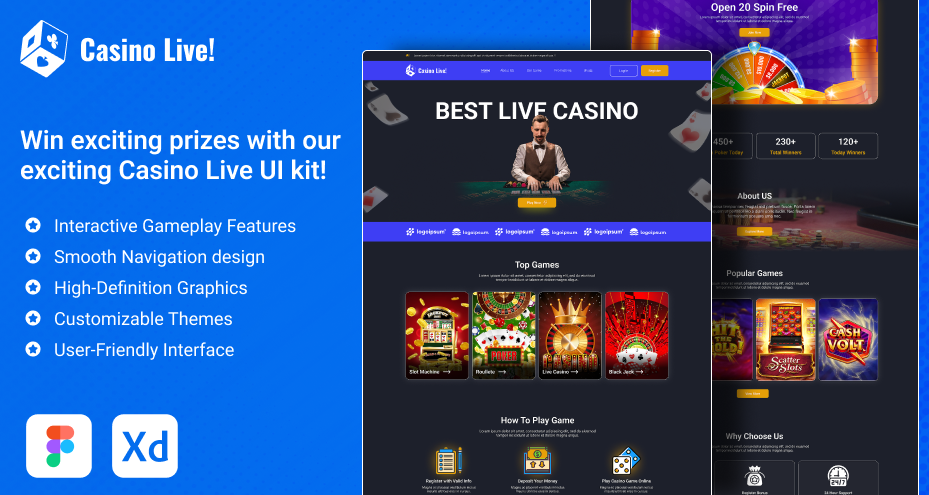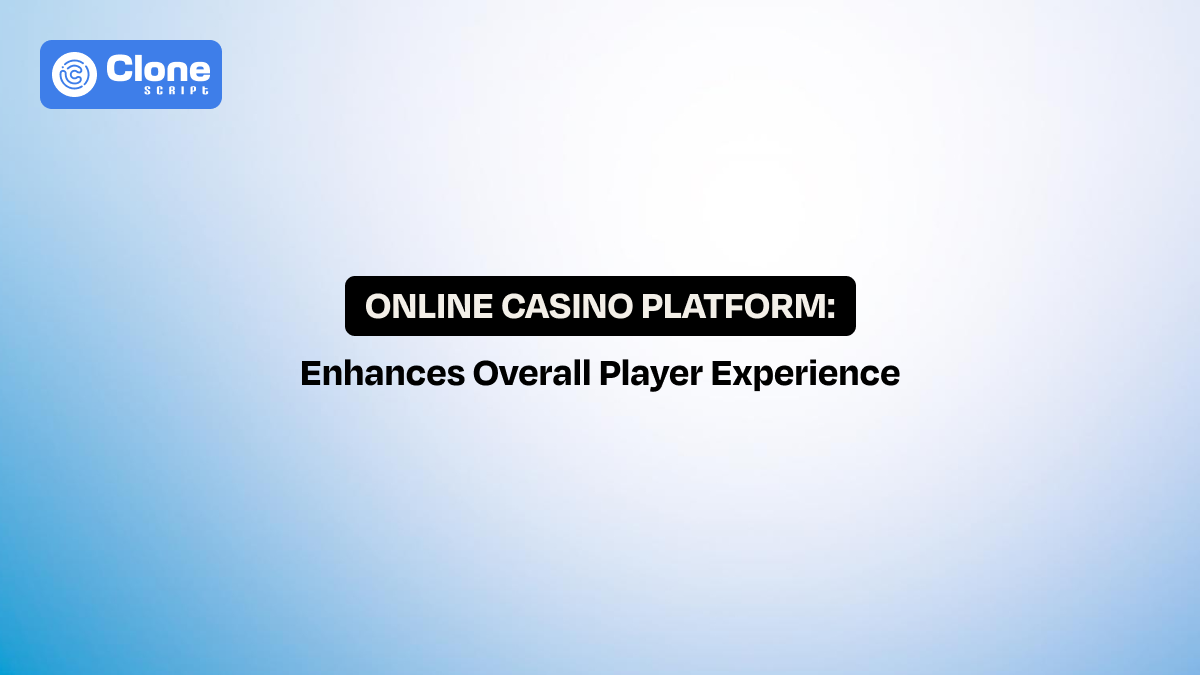How to Build a Profitable Online Casino Website from Scratch - The Complete Guide
The rise of the online casino website industry has completely transformed how people experience gambling. What was once limited to physical casinos is now available instantly on mobile and desktop, creating an industry worth over $78 billion annually and projected to grow rapidly in the coming years. But with this growth comes fierce competition, and simply buying a casino website template or adding a few slot games is no longer enough to succeed.
For developers, the challenge is technical: casino website design must be mobile-first, secure, and scalable while meeting strict licensing and compliance requirements. For operators, the challenge is business-focused: creating a profitable business model, integrating a secure payment gateway, and delivering gambling features that build trust and engagement.
This guide serves as a practical step-by-step guide to starting an online casino. Whether you’re a web developer, investor, or casino entrepreneur, you’ll get knowledge on how to design, launch, and grow a platform that stands out in one of the world’s most competitive digital markets.
What Is an Online Casino Website?
An online casino website is a digital platform where users can play real-money gambling games such as slots, blackjack, roulette, poker, and even live dealer experiences. They can play all games directly from their desktop or mobile device. Unlike traditional casinos, these websites are designed by professional UI/UX developers who combine entertainment, compliance, and security into one platform.
At its core, an online casino operates on three layers:
-
Front-end design —This is the user-facing interface, often powered by a custom build or a premium casino website template. Everything related to website UI/UX design, mobile responsiveness, intuitive navigation, and engaging visuals integration is managed at this layer.
-
Back-end infrastructure — This is the gaming engine to control payment systems and security frameworks. It handles deposits, withdrawals, and ensures a flexible real-time gameplay.
-
Compliance and licensing — This layer is dedicated to the adherence to gambling regulations, RNG (Random Number Generator) certifications, and responsible gaming practices. To build player trust, compliance with gambling rules is important.
For developers, understanding these layers is important to building an online casino website that meets both technical and legal standards. For businesses, it’s about choosing the right profitable casino business model, from white-label setups to fully custom platforms.
In short, a casino website is not just a gaming portal — it’s a complex ecosystem that must combine technology, regulation, and marketing to succeed in a highly competitive market.
Why Build a Profitable Online Casino Website?
The online gambling industry presents one of the most lucrative and appropriate opportunities for developers and business owners alike. With the global iGaming market expected to surpass $100 billion by 2030, building a well-designed online casino website can generate substantial revenue when paired with a profitable business model.
There are several compelling reasons to invest:
-
There is a high demand for mobile gaming.
Over 70% of online casino traffic comes from mobile devices, emphasizing the importance of a casino website that is responsive and intuitive. Players expect fast load times, easy navigation, and seamless gameplay. If the site is not optimized properly in terms of loading speed, navigation, or feature usage, it prevents players from playing the casino games.
-
It unlocks multiple revenue streams.
Online casinos can earn through various methods, like house edge, subscription models, affiliate programs, tournaments, or hybrid revenue approaches. Smart operators structure a profitable online casino business model to maximize lifetime value (LTV) while optimizing acquisition costs.
-
A scalable business opportunity is available.
Unlike land-based casinos, an online platform can reach a global audience with relatively lower overhead. Combining the secure technology stack with a secure payment gateway integration with the website ensures fast deposits, withdrawals, and reliable transactions, which builds player trust.
-
Data-driven growth maximizes the returns.
Online platforms allow operators to track player behavior, preferences, and engagement patterns. These insights enable continuous optimization of game offerings, promotions, and marketing strategies. From there, getting expected results is simplified with this approach.
In short, a thoughtfully developed casino website is beyond just a product. It’s a scalable business that can deliver high returns if built with the right technology, design, and promotional strategy.
7 Steps On How to Build an Online Casino Website from Scratch
Creating a successful online casino is not enough to code the site alone. It requires a strategic approach that balances technology, compliance, user experience, and business growth. Here’s a comprehensive, step-by-step guide for developers and casino operators to make it secure, scalable, and profitable:
Step 1. Define Target Market & Licensing Strategy.
Before you start website development, research the markets you want to target. Each region has unique gambling regulations that affect the games you can offer, the payment methods you can integrate, and how you can advertise your casino.
-
Popular licenses include the UK Gambling Commission (UKGC) and the Malta Gaming Authority (MGA). Understanding these rules early saves time, avoids legal issues, and allows you to design a casino website that aligns with regulatory standards.
Additionally, study local player behavior, preferred games, and popular payment methods. This approach helps your platform meet user expectations from day one.
Step 2. Choose a Profitable Online Casino Business Model.
A well-planned business model is the primary element of profitability. The revenue-earning model ranges from house edge games to subscription models and tournaments to affiliate partnerships.
-
Many successful operators use a hybrid model combining multiple revenue streams. It’s crucial to calculate player lifetime value (LTV) against customer acquisition costs (CAC) to ensure the platform is profitable.
-
Add retention features like loyalty programs, VIP tiers, and personalized promotions, which not only improve engagement but also significantly boost long-term revenue.
Step 3. Select Your Platform: White-Label, Custom, or Hybrid.
Your platform choice impacts cost, speed, and flexibility of casino website development:
-
White-label solutions: This option is suitable for a quick launch and has a lower upfront investment. There is minimal technical work to do, like frontend website development. Ideal for operators entering the market fast.
-
Custom build: To get full control over the casino website design, UX, and features, custom web development is an ideal choice. If your business is aiming to differentiate itself from the competition, this option can work properly.
-
Hybrid approach: It combines off-the-shelf gaming engines with a custom front-end design. This approach balances speed, customization, and scalability. Adding new games, features, or payment options as your business grows is becoming easier.
Step 4. Design & User Experience
A great casino website design keeps players engaged from the moment they land. Once they’re on the site, it’s your responsibility to fulfill their intents, whether it’s depositing an amount to the wallet or starting to play a game right away.

Here are some of the tips to consider:
-
Use a mobile-first and responsive layout to offer a professional gaming experience. Focus on fast-loading pages and intuitive navigation.
-
Highlight trust signals like licensing badges and a payment gateway to allow players to deposit and withdraw amounts.
-
Add features like personalized game recommendations, demo modes, live dealer interfaces, and smooth onboarding flows to make the experience immersive.
You can try to get a frontend-ready casino website template, as it is optimized for every aspect, from UI/UX design to technology integration.
In short, thoughtful UX increases player retention and encourages higher deposits over time.
Step 5. Integrate Games & Payment Systems
Partner with certified game providers such as NetEnt, Evolution, or Pragmatic Play for a wide selection of high-quality games. A robust payment system is equally important—integrate credit/debit cards, e-wallets, local payment methods, and crypto where legal.
-
Ensure deposits and withdrawals are fast and reliable. Keep note that delayed or failed payments can break trust and player loyalty.
Consider including a bonus and promo engine that automates rewards and incentives to keep players engaged.
Step 6. Ensure Security & Compliance.
Security builds trust and protects your casino business, and it’s in your favor already to avoid legal obligation and a permanent ban from serving the platform. Here is a checklist to consider for making a casino website secure:
-
Implement KYC/AML verification, SSL/TLS encryption, RNG-certified games, and real-time fraud detection.
-
Include responsible gaming features like deposit limits, self-exclusion, and activity monitoring.
-
Compliance with GDPR, CCPA, and other regional data protection laws ensures player safety and avoids hefty fines.
Regular security audits and updates keep your platform resilient against emerging threats.
Step 7. Test, Launch & Optimize
Before a full launch of the gambling website, run a soft launch with a limited audience to test UX, payment flows, and gameplay performance. Here are the options to check for:
-
Track metrics such as retention, deposits, and engagement to identify areas for improvement.
-
Use A/B testing for onboarding flows, game placement, and promotional campaigns. If find relevant results from the first method instead of the second, then prioritize it and confirm with the client, too.
In short, continuous iteration makes your online casino website evolve with player behavior, new games, and emerging trends. This can maximize profitability and competitiveness.
By following these seven steps, developers and operators can build an online casino website that is secure, compliant, user-friendly, and built to generate sustainable revenue. From there, it gives them a competitive edge in a fast-growing market.
6 Common Challenges While Building a Casino Website
Building a successful online casino website is a rewarding but complex endeavor. Developers and operators often encounter several challenges that, if not addressed early, can affect performance, compliance, and profitability.
-
Navigating Regulatory Complexity Is Tough.
Gambling laws differ across countries, and licenses like UKGC or MGA impact which games, promotions, and payment methods you can offer. Developers must implement KYC, AML, and geo-blocking to stay compliant and avoid costly fines. Early planning reduces legal risks and ensures smooth market entry.
-
Securing Reliable Payment Gateways Requires Setup.
A secure payment gateway for online casinos is vital for player trust. Platforms must support credit/debit cards, e-wallets, local payment methods, and cryptocurrency where legal. Thorough QA and testing of deposits and withdrawals prevent delays, errors, and lost revenue.
-
Preventing Fraud and Money Laundering Needs Monitoring.
Online casinos face high risks of fraud and money laundering. Implementing real-time monitoring, fraud detection systems, and AML protocols protects both players and the business without affecting legitimate users.
-
Scaling Live Dealer and Real-Time Games Remains Costly.
Live dealer experiences require low-latency streaming, optimized servers, and scalable infrastructure. Planning for peak traffic ensures smooth gameplay, reduces downtime, and keeps players engaged.
-
Retention vs. Acquisition Challenges Have to Be Prioritized.
Acquiring new players is costly, but retaining them is even harder. Focus on user experience, onboarding flows, loyalty programs, and personalized promotions to increase engagement, lifetime value, and long-term revenue.
-
Technical Complexity and Platform Maintenance
Building a casino platform involves integrating multiple systems: game engines, payment gateways, analytics, CRM, bonus engines, and security modules. Ensuring these components work together reliably requires skilled developers and continuous maintenance. Neglecting updates or failing to monitor performance can result in downtime, errors, or security vulnerabilities.
In short, overcoming these challenges requires careful planning, expert development, regulatory foresight, and continuous optimization.
Conclusion
A great online casino isn’t just about games—it’s about creating an experience players trust and enjoy. From smooth mobile design and secure payments to engaging features and smart business planning, every detail matters. Challenges like regulations, fraud, and scaling are real, but tackling them head-on builds credibility and loyalty. Keep improving, focus on the player, and your platform can be successful. Success comes when technology, compliance, and user experience work together seamlessly.
FAQs
-
What is the best approach for casino platform scalability?
Use modular architecture, cloud hosting, and a hybrid platform approach to easily integrate new games, payment options, and features while handling peak traffic without performance issues.
-
How can operators maximize profitability?
Focus on a profitable online casino business model, combining multiple revenue streams (house edge, subscriptions, tournaments, affiliate programs), retention strategies, and continuous optimization of UX and marketing campaigns.
-
What features make a successful online casino website?
Key features include responsive casino website design, diverse game portfolio, secure payments, licensing compliance, analytics, loyalty programs, promotional tools, and scalable architecture for growth and long-term retention.
-
How can I improve user engagement on a casino platform?
Enhance casino website engagement by implementing personalized recommendations, smooth onboarding, loyalty programs, live dealer games, optimized mobile UX, and data-driven analytics for targeted retention strategies.
-
How much does it cost to develop an online casino website?
The cost to develop an online casino website ranges from $10,000–$50,000 for white-label solutions to $100,000–$500,000+ for custom platforms, plus licensing, secure payment integration, game providers, and ongoing maintenance.
-
Which technologies are commonly used to build an online casino website?
Technologies used in an online casino website development include HTML5, CSS3, JavaScript, React, and Angular for the front-end. For backend development, Node.js, PHP, Python, or Java are used. MySQL/MongoDB can be a perfect option for databases, plus RNG engines, SSL encryption, and secure payment APIs.
 BTC - Bitcoin
BTC - Bitcoin
 USDTERC20 - USDT ERC20
USDTERC20 - USDT ERC20
 ETH - Ethereum
ETH - Ethereum
 BNB - Binance
BNB - Binance
 BCH - Bitcoin Cash
BCH - Bitcoin Cash
 DOGE - Dogecoin
DOGE - Dogecoin
 TRX - TRON
TRX - TRON
 USDTTRC20 - USD TRC20
USDTTRC20 - USD TRC20
 LTC - LiteCoin
LTC - LiteCoin







